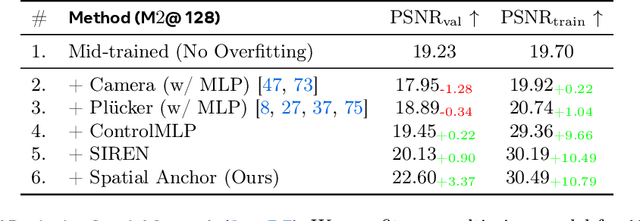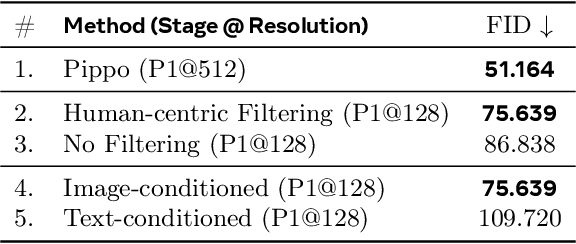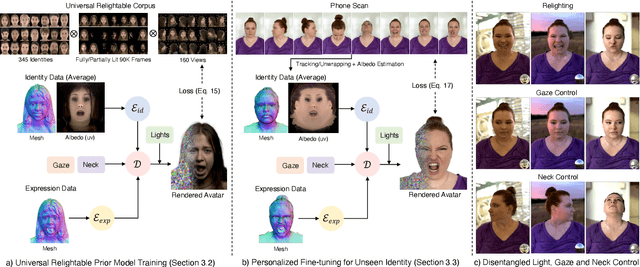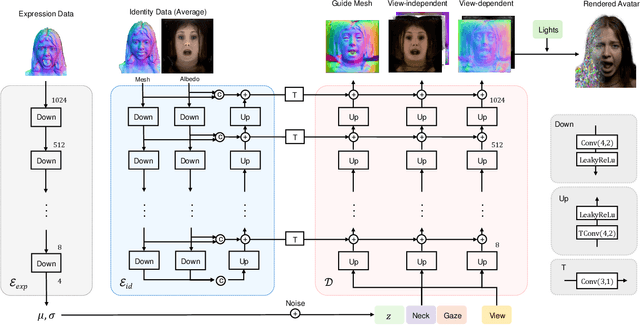Rawal Khirodkar
Capture, Canonicalize, Splat: Zero-Shot 3D Gaussian Avatars from Unstructured Phone Images
Oct 15, 2025Abstract:We present a novel, zero-shot pipeline for creating hyperrealistic, identity-preserving 3D avatars from a few unstructured phone images. Existing methods face several challenges: single-view approaches suffer from geometric inconsistencies and hallucinations, degrading identity preservation, while models trained on synthetic data fail to capture high-frequency details like skin wrinkles and fine hair, limiting realism. Our method introduces two key contributions: (1) a generative canonicalization module that processes multiple unstructured views into a standardized, consistent representation, and (2) a transformer-based model trained on a new, large-scale dataset of high-fidelity Gaussian splatting avatars derived from dome captures of real people. This "Capture, Canonicalize, Splat" pipeline produces static quarter-body avatars with compelling realism and robust identity preservation from unstructured photos.
Pippo: High-Resolution Multi-View Humans from a Single Image
Feb 11, 2025



Abstract:We present Pippo, a generative model capable of producing 1K resolution dense turnaround videos of a person from a single casually clicked photo. Pippo is a multi-view diffusion transformer and does not require any additional inputs - e.g., a fitted parametric model or camera parameters of the input image. We pre-train Pippo on 3B human images without captions, and conduct multi-view mid-training and post-training on studio captured humans. During mid-training, to quickly absorb the studio dataset, we denoise several (up to 48) views at low-resolution, and encode target cameras coarsely using a shallow MLP. During post-training, we denoise fewer views at high-resolution and use pixel-aligned controls (e.g., Spatial anchor and Plucker rays) to enable 3D consistent generations. At inference, we propose an attention biasing technique that allows Pippo to simultaneously generate greater than 5 times as many views as seen during training. Finally, we also introduce an improved metric to evaluate 3D consistency of multi-view generations, and show that Pippo outperforms existing works on multi-view human generation from a single image.
URAvatar: Universal Relightable Gaussian Codec Avatars
Oct 31, 2024



Abstract:We present a new approach to creating photorealistic and relightable head avatars from a phone scan with unknown illumination. The reconstructed avatars can be animated and relit in real time with the global illumination of diverse environments. Unlike existing approaches that estimate parametric reflectance parameters via inverse rendering, our approach directly models learnable radiance transfer that incorporates global light transport in an efficient manner for real-time rendering. However, learning such a complex light transport that can generalize across identities is non-trivial. A phone scan in a single environment lacks sufficient information to infer how the head would appear in general environments. To address this, we build a universal relightable avatar model represented by 3D Gaussians. We train on hundreds of high-quality multi-view human scans with controllable point lights. High-resolution geometric guidance further enhances the reconstruction accuracy and generalization. Once trained, we finetune the pretrained model on a phone scan using inverse rendering to obtain a personalized relightable avatar. Our experiments establish the efficacy of our design, outperforming existing approaches while retaining real-time rendering capability.
Harmony4D: A Video Dataset for In-The-Wild Close Human Interactions
Oct 27, 2024



Abstract:Understanding how humans interact with each other is key to building realistic multi-human virtual reality systems. This area remains relatively unexplored due to the lack of large-scale datasets. Recent datasets focusing on this issue mainly consist of activities captured entirely in controlled indoor environments with choreographed actions, significantly affecting their diversity. To address this, we introduce Harmony4D, a multi-view video dataset for human-human interaction featuring in-the-wild activities such as wrestling, dancing, MMA, and more. We use a flexible multi-view capture system to record these dynamic activities and provide annotations for human detection, tracking, 2D/3D pose estimation, and mesh recovery for closely interacting subjects. We propose a novel markerless algorithm to track 3D human poses in severe occlusion and close interaction to obtain our annotations with minimal manual intervention. Harmony4D consists of 1.66 million images and 3.32 million human instances from more than 20 synchronized cameras with 208 video sequences spanning diverse environments and 24 unique subjects. We rigorously evaluate existing state-of-the-art methods for mesh recovery and highlight their significant limitations in modeling close interaction scenarios. Additionally, we fine-tune a pre-trained HMR2.0 model on Harmony4D and demonstrate an improved performance of 54.8% PVE in scenes with severe occlusion and contact. Code and data are available at https://jyuntins.github.io/harmony4d/.
Sapiens: Foundation for Human Vision Models
Aug 22, 2024Abstract:We present Sapiens, a family of models for four fundamental human-centric vision tasks - 2D pose estimation, body-part segmentation, depth estimation, and surface normal prediction. Our models natively support 1K high-resolution inference and are extremely easy to adapt for individual tasks by simply fine-tuning models pretrained on over 300 million in-the-wild human images. We observe that, given the same computational budget, self-supervised pretraining on a curated dataset of human images significantly boosts the performance for a diverse set of human-centric tasks. The resulting models exhibit remarkable generalization to in-the-wild data, even when labeled data is scarce or entirely synthetic. Our simple model design also brings scalability - model performance across tasks improves as we scale the number of parameters from 0.3 to 2 billion. Sapiens consistently surpasses existing baselines across various human-centric benchmarks. We achieve significant improvements over the prior state-of-the-art on Humans-5K (pose) by 7.6 mAP, Humans-2K (part-seg) by 17.1 mIoU, Hi4D (depth) by 22.4% relative RMSE, and THuman2 (normal) by 53.5% relative angular error.
Generalizable Neural Human Renderer
Apr 22, 2024Abstract:While recent advancements in animatable human rendering have achieved remarkable results, they require test-time optimization for each subject which can be a significant limitation for real-world applications. To address this, we tackle the challenging task of learning a Generalizable Neural Human Renderer (GNH), a novel method for rendering animatable humans from monocular video without any test-time optimization. Our core method focuses on transferring appearance information from the input video to the output image plane by utilizing explicit body priors and multi-view geometry. To render the subject in the intended pose, we utilize a straightforward CNN-based image renderer, foregoing the more common ray-sampling or rasterizing-based rendering modules. Our GNH achieves remarkable generalizable, photorealistic rendering with unseen subjects with a three-stage process. We quantitatively and qualitatively demonstrate that GNH significantly surpasses current state-of-the-art methods, notably achieving a 31.3% improvement in LPIPS.
Real-Time Simulated Avatar from Head-Mounted Sensors
Mar 11, 2024



Abstract:We present SimXR, a method for controlling a simulated avatar from information (headset pose and cameras) obtained from AR / VR headsets. Due to the challenging viewpoint of head-mounted cameras, the human body is often clipped out of view, making traditional image-based egocentric pose estimation challenging. On the other hand, headset poses provide valuable information about overall body motion, but lack fine-grained details about the hands and feet. To synergize headset poses with cameras, we control a humanoid to track headset movement while analyzing input images to decide body movement. When body parts are seen, the movements of hands and feet will be guided by the images; when unseen, the laws of physics guide the controller to generate plausible motion. We design an end-to-end method that does not rely on any intermediate representations and learns to directly map from images and headset poses to humanoid control signals. To train our method, we also propose a large-scale synthetic dataset created using camera configurations compatible with a commercially available VR headset (Quest 2) and show promising results on real-world captures. To demonstrate the applicability of our framework, we also test it on an AR headset with a forward-facing camera.
Multi-Person 3D Pose Estimation from Multi-View Uncalibrated Depth Cameras
Jan 28, 2024Abstract:We tackle the task of multi-view, multi-person 3D human pose estimation from a limited number of uncalibrated depth cameras. Recently, many approaches have been proposed for 3D human pose estimation from multi-view RGB cameras. However, these works (1) assume the number of RGB camera views is large enough for 3D reconstruction, (2) the cameras are calibrated, and (3) rely on ground truth 3D poses for training their regression model. In this work, we propose to leverage sparse, uncalibrated depth cameras providing RGBD video streams for 3D human pose estimation. We present a simple pipeline for Multi-View Depth Human Pose Estimation (MVD-HPE) for jointly predicting the camera poses and 3D human poses without training a deep 3D human pose regression model. This framework utilizes 3D Re-ID appearance features from RGBD images to formulate more accurate correspondences (for deriving camera positions) compared to using RGB-only features. We further propose (1) depth-guided camera-pose estimation by leveraging 3D rigid transformations as guidance and (2) depth-constrained 3D human pose estimation by utilizing depth-projected 3D points as an alternative objective for optimization. In order to evaluate our proposed pipeline, we collect three video sets of RGBD videos recorded from multiple sparse-view depth cameras and ground truth 3D poses are manually annotated. Experiments show that our proposed method outperforms the current 3D human pose regression-free pipelines in terms of both camera pose estimation and 3D human pose estimation.
Ego-Exo4D: Understanding Skilled Human Activity from First- and Third-Person Perspectives
Nov 30, 2023



Abstract:We present Ego-Exo4D, a diverse, large-scale multimodal multiview video dataset and benchmark challenge. Ego-Exo4D centers around simultaneously-captured egocentric and exocentric video of skilled human activities (e.g., sports, music, dance, bike repair). More than 800 participants from 13 cities worldwide performed these activities in 131 different natural scene contexts, yielding long-form captures from 1 to 42 minutes each and 1,422 hours of video combined. The multimodal nature of the dataset is unprecedented: the video is accompanied by multichannel audio, eye gaze, 3D point clouds, camera poses, IMU, and multiple paired language descriptions -- including a novel "expert commentary" done by coaches and teachers and tailored to the skilled-activity domain. To push the frontier of first-person video understanding of skilled human activity, we also present a suite of benchmark tasks and their annotations, including fine-grained activity understanding, proficiency estimation, cross-view translation, and 3D hand/body pose. All resources will be open sourced to fuel new research in the community.
EgoHumans: An Egocentric 3D Multi-Human Benchmark
May 25, 2023



Abstract:We present EgoHumans, a new multi-view multi-human video benchmark to advance the state-of-the-art of egocentric human 3D pose estimation and tracking. Existing egocentric benchmarks either capture single subject or indoor-only scenarios, which limit the generalization of computer vision algorithms for real-world applications. We propose a novel 3D capture setup to construct a comprehensive egocentric multi-human benchmark in the wild with annotations to support diverse tasks such as human detection, tracking, 2D/3D pose estimation, and mesh recovery. We leverage consumer-grade wearable camera-equipped glasses for the egocentric view, which enables us to capture dynamic activities like playing soccer, fencing, volleyball, etc. Furthermore, our multi-view setup generates accurate 3D ground truth even under severe or complete occlusion. The dataset consists of more than 125k egocentric images, spanning diverse scenes with a particular focus on challenging and unchoreographed multi-human activities and fast-moving egocentric views. We rigorously evaluate existing state-of-the-art methods and highlight their limitations in the egocentric scenario, specifically on multi-human tracking. To address such limitations, we propose EgoFormer, a novel approach with a multi-stream transformer architecture and explicit 3D spatial reasoning to estimate and track the human pose. EgoFormer significantly outperforms prior art by 13.6% IDF1 and 9.3 HOTA on the EgoHumans dataset.
 Add to Chrome
Add to Chrome Add to Firefox
Add to Firefox Add to Edge
Add to Edge